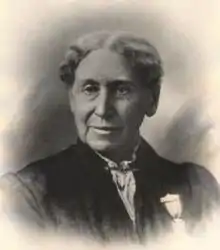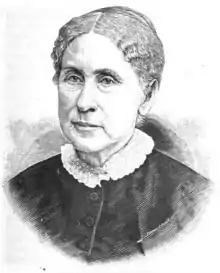Annie Wittenmyer | |
|---|---|
 | |
| Born | Sarah Turner August 26, 1827 Adams County, Ohio |
| Died | February 2, 1900 (aged 72) Pottstown, Pennsylvania |
| Occupation | Social reformer |
| Spouse | William Wittenmyer |
| Signature | |
Sarah "Annie" Turner Wittenmyer (August 26, 1827 – February 2, 1900) was an American social reformer, relief worker, and writer. She served as the first President of the Women's Christian Temperance Union from 1874 to 1879.[1] The Iowa Soldiers' Orphans' Home was renamed the Annie Wittenmyer Home in 1949 in her honor.
Early years
Born in Sandy Springs, Adams County, Ohio in 1827,[2] she attended a seminary for girls. She married merchant William Wittenmyer at age 20.[3] In 1850, they moved to Keokuk, Iowa, and she started a Sunday School and a tuition-free school for underprivileged children in 1853. She also developed a Methodist congregation from these children and wrote several hymns. Three of her four children died before reaching adulthood, and her husband died in 1860.
The Civil War
When the American Civil War began in April 1861 and reports of suffering soldiers reached the home front, she responded by traveling to military hospitals and describing the horrible conditions she witnessed prompting local support. When the Keokuk Ladies' Soldiers' Aid Society began in May 1861, she became its "Corresponding Secretary" with the responsibility to maintain contact with sister organizations around the state.[4] In 1862, Wittenmyer became the first woman mentioned by name in an Iowa legislative document when she was appointed as a Sanitary Agent for the Iowa State Sanitary Commission. In 1863, she began advocating for war orphans, helping to create several new Iowa orphanages, including the Iowa Soldiers' Orphans' Home, which was later renamed the Annie Wittenmyer Home. After she encountered public and prolonged disagreements between the Keokuk Ladies Aid Society and the Iowa Army Sanitary Commission, she resigned her local relief work in 1864 to work with the United States Christian Commission in developing their special diet kitchens for Civil War hospitals.[5]
This program was designed both to improve the health of soldiers who were reportedly dying from inadequate diet in hospitals and also provide a vehicle for women with an interest in missionary work to gain entry to Civil War hospitals and access to soldiers. Mary and Amanda Shelton and other "lady managers" created diet kitchens in a number of hospitals, not without encountering considerable resistance.[6] After the war, Wittenmyer wrote Under the Guns, chronicling her relief work.[7]
Post-War work
Following the war, she helped found the Woman's Home Missionary Society and served as their first corresponding secretary in 1871. She edited the periodicals The Christian Woman and The Christian Child, and she wrote several more hymns and the book Woman's Work for Jesus.[8]
During Wittenmyer's tenure as first president of the Women's Christian Temperance Union, the group grew to over 1,000 local chapters. She edited their periodical Our Union and published two books on the topic: Her book History of the Women's Temperance Crusade in 1878, and Women of the Reformation in 1884. She was succeeded by Frances Willard when the organization began to focus on women's suffrage. Wittenmyer strongly opposed women's suffrage; like some other women, she believed that entering the corrupt world of partisan politics would greatly reduce women's moral authority.

Wittenmyer then returned to medical advocacy for veterans and nurses.[9] In 1889 she was elected President of the Woman's Relief Corps and focused on providing retirement living for nurses and war widows.[10] She lobbied for pensions for retired military nurses, leading to legislation passed in 1892. She published her autobiography Under the Guns in 1895 and received her own pension in 1898. In 1898, she was elected president of the Non-Partisan National Woman's Christian Temperance Union.[11]
Personal life
Wittenmyer died of an asthma attack in Pottstown, Pennsylvania following a lecture and was buried in Sanatoga, Montgomery County.[12]
The Woman's Christian Temperance Union's Annie Wittenmyer White Ribbon Award is named in her honor, and in 1949 the Iowa Soldiers' Orphans' Home was renamed the Annie Wittenmyer Home in her honor. It previously housed a branch of the Davenport Public Library and currently houses The Parks and Recreation Department and several children's organizations.
References
- ↑ Riley, Glenda (1986). Annie Turner Wittenmyer: Reformer. Iowa Woman, September 1986, pp. 26–33.
- ↑ "Mrs. Annie Wittenmyer". The Annals of Iowa. 4 (4). January 1, 1900. ISSN 0003-4827.
- ↑ "Famous Iowans - Annie Wittenmyer | DesMoinesRegister.com". data.desmoinesregister.com. Retrieved March 8, 2017.
- ↑ Leonard, Elizabeth D. (2008). ""Men Did Not Take to the Musket More Commonly than Women to the Needle": Annie Wittenmyer and Soldiers' Aid." In Marvin Bergman, ed., Iowa History Reader, pp. 105-127. Iowa City: University of Iowa Press.
- ↑ Guinn, L. (2015). "Annie Wittenmyer and Nineteenth-Century Women's Usefulness". The Annals of Iowa. 74 (4): 351–377. doi:10.17077/0003-4827.12232.
- ↑ McDevitt, T. (2004). "" A Melody Before Unknown": the Civil War Experiences of Mary and Amanda Shelton". The Annals of Iowa. 63 (2): 105–136. doi:10.17077/0003-4827.10789.
- ↑ Wittenmyer, Annie. Under the guns : a woman's reminiscences of the civil war. E.B. Stillings.
- ↑ Sillanpa, Tom. Annie Wittenmyer: God's Angel. (Hamilton, IL: Hamilton Press), 1972.
- ↑ Staff report (August 1, 1886). A union of human societies. The New York Times
- ↑ Staff report (September 15, 1895,). Woman's Relief Corps Officers. The New York Times
- ↑ "Progress of the Movement". The National Advocate. New York: National Temperance Society. 33 (3): 45. 1898. Retrieved December 3, 2022.
 This article incorporates text from this source, which is in the public domain.
This article incorporates text from this source, which is in the public domain. - ↑ Staff report (February 3, 1900). "A Great Work Done: Death of Mrs. Annie Wittenmeyer, the Philanthropist". Davenport Democrat and Leader p. 10
External links
- Annie Wittenmyer via Davenport Public Library
- Annie Wittenmyer photo via Woman's Christian Temperance Union